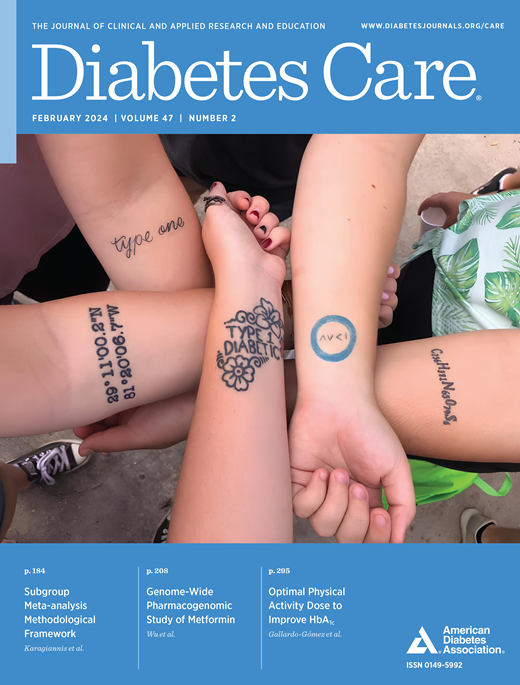先进的混合闭环疗法与标准胰岛素疗法在 1 型糖尿病妇女产前和产后早期的比较:来自 CRISTAL 随机对照试验的二次观察分析
IF 14.8
1区 医学
Q1 ENDOCRINOLOGY & METABOLISM
引用次数: 0
摘要
目的 确定 1 型糖尿病(T1D)孕妇产前和产后早期高级混合闭环疗法(AHCL)与标准胰岛素疗法相比的疗效和安全性。研究设计和方法 CRISTAL 是一项在比利时和荷兰进行的双臂、开放标签、随机对照试验,将 95 名 1 型糖尿病孕妇 1:1 分配到 MiniMed 780G AHCL 系统(n = 46)或标准胰岛素疗法(n = 49)。这项预设的二次观察分析重点关注产前继续使用 AHCL(n = 27)和/或产后早期使用 AHCL(n = 37,直至出院)的原 AHCL 组参与者与产前使用标准胰岛素疗法(n = 45)和/或产后早期使用标准胰岛素疗法(n = 34)的原标准胰岛素疗法组参与者之间血糖控制和安全性结果的差异。结果 在分别完成试验的 43 名 AHCL 组和 46 名标准胰岛素治疗组参与者中,27 名 AHCL 组参与者(62.8%)继续使用 AHCL,45 名标准胰岛素治疗组参与者(97.8%)继续在产期使用标准胰岛素治疗。与标准胰岛素疗法相比,产中 AHCL 与血糖在 3.5-7.8 mmol/L 范围内的时间更长(71.5 ± 17.7% vs. 63.1 ± 17.0%,P = 0.030),高于>7.8 mmol/L范围的时间较少(27.3 ± 17.4% vs. 35.3 ± 17.5%,P = 0.054),低于<3.5 mmol/L范围的时间没有增加(1.1 ± 2.4% vs. 1.5 ± 2.3%,P = 0.146)。产后早期,37 名(86.0%)随机接受 AHCL 的参与者继续接受 AHCL,胰岛素与碳水化合物比率的中位数增加了 67%(四分位间范围 -14 至 126)。与标准胰岛素疗法相比,AHCL 的血糖控制同样严格(3.9-10.0 mmol/L:86.8 ± 6.7% vs. 83.8 ± 8.1%,P = 0.124)。两组患者均未出现严重低血糖或糖尿病酮症酸中毒。结论 AHCL 能有效维持产前和产后早期严格的血糖控制,并能在胰岛素需求快速变化期间安全地持续使用。本文章由计算机程序翻译,如有差异,请以英文原文为准。
Advanced Hybrid Closed-Loop Therapy Compared With Standard Insulin Therapy Intrapartum and Early Postpartum in Women With Type 1 Diabetes: A Secondary Observational Analysis From the CRISTAL Randomized Controlled Trial
OBJECTIVE To determine efficacy and safety of intrapartum and early postpartum advanced hybrid closed-loop (AHCL) therapy compared with standard insulin therapy in pregnant women with type 1 diabetes (T1D). RESEARCH DESIGN AND METHODS CRISTAL was a double-arm, open-label, randomized controlled trial performed in Belgium and the Netherlands that assigned 95 pregnant participants with T1D 1:1 to a MiniMed 780G AHCL system (n = 46) or standard insulin therapy (n = 49). This prespecified, secondary observational analysis focused on differences in glycemic control and safety outcomes between participants from the original AHCL group who continued AHCL intrapartum (n = 27) and/or early postpartum (n = 37, until hospital discharge) and those from the original standard insulin therapy group using standard insulin therapy intrapartum (n = 45) and/or early postpartum (n = 34). RESULTS Of the 43 and 46 participants in the AHCL and standard insulin therapy groups, respectively, completing the trial, 27 (62.8%) in the AHCL group continued AHCL and 45 in the standard insulin therapy group (97.8%) continued standard insulin therapy intrapartum. Compared with standard insulin therapy, intrapartum AHCL was associated with more time in range 3.5–7.8 mmol/L (71.5 ± 17.7% vs. 63.1 ± 17.0%, P = 0.030) and numerically lower time above range >7.8 mmol/L (27.3 ± 17.4% vs. 35.3 ± 17.5%, P = 0.054), without increases in time below range <3.5 mmol/L (1.1 ± 2.4% vs. 1.5 ± 2.3%, P = 0.146). Early postpartum, 37 (86.0%) participants randomized to AHCL continued AHCL, with a median increase in insulin-to-carbohydrate ratios of 67% (interquartile range −14 to 126). Similar tight glycemic control (3.9–10.0 mmol/L: 86.8 ± 6.7% vs. 83.8 ± 8.1%, P = 0.124) was observed with AHCL versus standard insulin therapy. No severe hypoglycemia or diabetic ketoacidosis was reported in either group. CONCLUSIONS AHCL is effective in maintaining tight glycemic control intrapartum and early postpartum and can be safely continued during periods of rapidly changing insulin requirements.
求助全文
通过发布文献求助,成功后即可免费获取论文全文。
去求助
来源期刊

Diabetes Care
医学-内分泌学与代谢
CiteScore
27.80
自引率
4.90%
发文量
449
审稿时长
1 months
期刊介绍:
The journal's overarching mission can be captured by the simple word "Care," reflecting its commitment to enhancing patient well-being. Diabetes Care aims to support better patient care by addressing the comprehensive needs of healthcare professionals dedicated to managing diabetes.
Diabetes Care serves as a valuable resource for healthcare practitioners, aiming to advance knowledge, foster research, and improve diabetes management. The journal publishes original research across various categories, including Clinical Care, Education, Nutrition, Psychosocial Research, Epidemiology, Health Services Research, Emerging Treatments and Technologies, Pathophysiology, Complications, and Cardiovascular and Metabolic Risk. Additionally, Diabetes Care features ADA statements, consensus reports, review articles, letters to the editor, and health/medical news, appealing to a diverse audience of physicians, researchers, psychologists, educators, and other healthcare professionals.
 求助内容:
求助内容: 应助结果提醒方式:
应助结果提醒方式:


